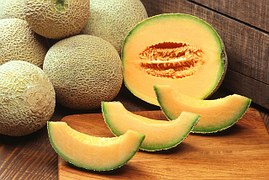Hallelujah, it’s time for the sweet fruits of summer! Cantaloupe, or “muskmelon,” is a special treat this time of year. The harvest season for cantaloupe is actually June through October, but locally they are peak from mid-July to mid-August.
Cantaloupes are thought to have originated in Africa. It is a nutritionally dense fruit choice. ¼ of a cantaloupe (approximately 1 cup) is only 50 calories and contains a whopping 120% of your RDA for vitamin A and 80% for vitamin C. Cantaloupe is fat free, low sodium, and a good source of folate. It also contains multiple varieties of antioxidants and phytonutrients, making it a nutritional powerhouse. Cantaloupe has a high water content, which helps you stay hydrated and feel full.
How should you choose a melon at the grocery store? Pick one that has an aromatic smell and yields slightly to pressure opposite the stem end. Blemishes or spots on the outside should not affect the quality of the melon on the inside; however bruising could indicate a lower quality melon. Cantaloupe will continue to ripen once harvested, but the sugar content (sweetness) will not increase. If you are buying pre-cut melon, make sure it is properly chilled. Once you get the cantaloupe home, the optimal storage site is in the refrigerator, where it will keep for five days. Keep it at room temperature for 1-2 days if it needs to ripen a bit. You can also preserve cantaloupe(PDF).
Once you are ready to cut your cantaloupe, it is important to follow basic food safety instructions, because growing melons are in direct contact with the ground. It is best to wash it just prior to cutting, not before refrigerating. Use water and a clean vegetable brush to clean the rind. Since many fruits and vegetables have porous skins (including cantaloupe), dishwashing soap is not recommended. Blot with paper towels and position on a clean cutting board. There are a variety of ways to cut your melon. I like to cut mine in half, scoop out the seeds with a spoon, and then finish off with a flourish by using a melon baller.
What are some ways to enjoy your cantaloupe other than eating it plain? It’s great on top of vanilla yogurt or ice cream. You can also place it on skewers with complimentary fruits such as strawberries, honeydew and/or pineapple. Growing up, my parents always shook a little bit of salt on their melon to enhance the sweetness. I enjoy freezing melon balls and using them in smoothies. You might want to be adventurous and try a chilled cantaloupe soup. But however you choose to eat cantaloupe, you can’t lose, because your body will be the winner!
Written by: Melissa Welker M.Ed., B.S., Family and Consumer Sciences Extension Educator, Ohio State University Extension, Fulton County, Maumee Valley EERA, welker.87@osu.edu
Reviewed by: Donna Green, Family & Consumer Sciences Educator, Ohio State University Extension, Erie County, Erie Basin EERA, green.308@osu.edu


